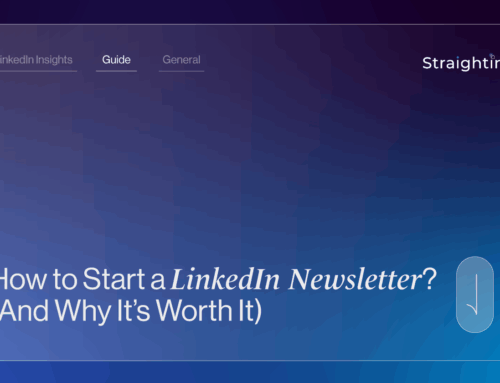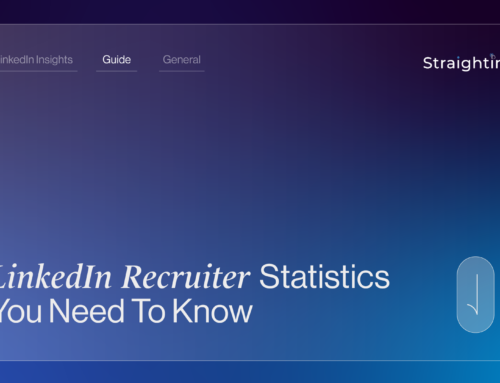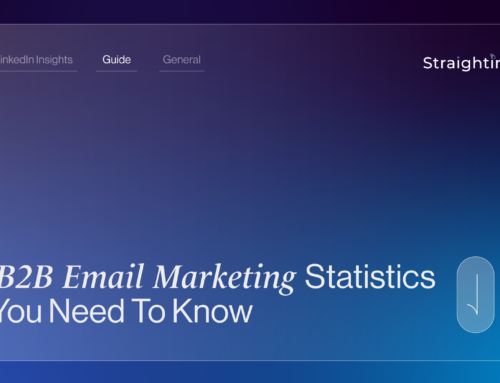Your LinkedIn profile is like your online CV or resume. It presents you professionally, which means you have to showcase your skills, experience, and expertise to the absolute best of your ability. One way you can do this is by adding a portfolio to your profile.
As a LinkedIn advertising agency, we know that not every working professionals needs a portfolio, especially if their work is not digitally visible. But certain industries, including creative arts and design, marketing, and advertising, as well as those working in website development, could benefit from adding one to their profile.
If you’re curious about how to add a portfolio to your LinkedIn profile, continue reading. We’ll discuss the benefits of adding your portfolio and how you can best display it below.
What is a portfolio?
A portfolio is a document that displays the highlights of your career experience. Like a resume or CV, it helps to validate your experience and can help you stand out against other applicants when it comes to recruitment. This can include anything from:
- Case studies
- Academic work and achievements
- Examples of the results you’ve achieved for clients
Ultimately, your portfolio is what you make of it – so there’s no set format you need to follow; just ensure it represents your best working self. For example, if you work in a creative field, try to do something different and demonstrate your artistic skills.
How to add a portfolio to your LinkedIn profile
To add an online portfolio to your LinkedIn profile, you need to first visit this page. Once you’re there, click the ‘Me’ icon and then click ‘Visit profile’. Next, take the following steps:
- Click ‘Add profile section’.

- Click ‘Recommended’.
- Select ‘Add featured’.

- Your existing featured posts/articles and other content will show up. Click the ‘Plus’ icon in the top right, and then click ‘Add a link’.
- Paste the link to your portfolio, then press save – and you’re done!
What to include in a LinkedIn portfolio
Now that you know how to add your portfolio to your LinkedIn profile, let’s take a deep dive into the types of items you should include within it. For example:
Headline and career summary
A LinkedIn portfolio is a way for you to summarise the highlights of your career so far, so it’s best to start off by adding context to what you do. Ensure your portfolio has a headline and career summary at the beginning. For example, you could use the following template:
“I am a driven and motivated [insert industry] professional with [state your years of experience] experience in [add technical abilities and skills that demonstrate your ability to perform]. My work has generated tangible results, including [add metrics or KPIs achieved here]. Check out some other pieces of my work in my portfolio and get in touch for information about further collaboration.”
If you want to improve your LinkedIn profile ahead of publishing your portfolio, check out our blog.
Examples of your work
Displaying examples of your work is a key part of developing your portfolio. Think of your portfolio as a presentation of all your career highlights and achievements – put simply, it provides tangible proof that you are able to do what you say you can do.
Avoid adding work examples of projects that share similarities with each other. Remember, you want to demonstrate your skill set – especially skills that are mentioned in a job advertisement. So, ensure you pick projects to display your ability to perform these actions.
Achievements and other successes
You should also display your career achievements and other related successes on your LinkedIn portfolio. There’s no point in demonstrating your skills and experience if you are unable to provide evidence of the results you are able to achieve.
For example, if any of your projects have received awards and other notable recognition, you should include this in your portfolio, as well as any results generated because of your work, e.g. metrics such as increased sales or CTR.
Case studies
Like examples of your work, you should also display case studies on your portfolio to establish proof of your work for big businesses and clients. This will further reiterate your ability to work with key figures, as well as prospective clientele and customers.
A case study should be formatted in a way that provides an overview of the project you managed, the objectives, the work you undertook, and the results generated. If you’re still unsure of how to write a case study, check out this blog on LinkedIn, which also offers a free template.
Recommendations
Finally, you could also include recommendations on your LinkedIn portfolio to further add credibility to it. Ask previous clients and colleagues for written statements that offer a testament to you and your career skills. For example, if it’s a previous client, ask them to highlight the results you’ve generated for them.
Previous colleagues can confirm your ability to perform certain skills and tasks by highlighting previous experiences of working with you.
If you’re interested in how to ask for LinkedIn recommendations, explore our blog where we delve into the details.
What are the benefits of showcasing a LinkedIn portfolio?
Your LinkedIn profile is an extension of your professional self, which is why uploading your portfolio to your account can provide several benefits when it comes to job seeking or showcasing the results of your business.
Let’s explore these benefits in more detail below:
Makes you a sought-after candidate
With a portfolio, you’re showing, not telling. Instead of asking a recruiter or business that’s hiring to trust your ability to perform certain tasks and actions, you can provide tangible evidence. This adds another level of credibility to your applications, and when recruiters compare it to others, it will make you stand out, as well as make you a more desirable candidate.
Further demonstrates your ability
Like your resume or CV, displaying your portfolio on LinkedIn showcases your ability to perform your role or work in the industry you do. For example, if you work in a creative field such as graphic design, it’s important to present your work visually so you can show your ability to produce well-crafted artwork.
Increases visibility of your profile
Adding a portfolio to your LinkedIn profile also helps to increase your visibility. As a portfolio is something viewers can engage and interact with, it might attract more views to your LinkedIn profile – and therefore increase potential business opportunities.
Propel company growth with a LinkedIn marketing strategy that drives conversions – contact StraightIn today
As a B2B business, you should be utilising LinkedIn marketing and advertising to attract leads, increase the visibility of your brand, and position yourself as a leader within your industry by sharing valuable content.
If you’re struggling to find time to do so, don’t fret. The experts at StraightIn are here to listen to your unique business goals and create a bespoke strategy that works toward them sooner rather than later.
Our services include Outreach Marketing, Content Marketing, and Personal Branding. Get in touch with us today to find out more about how we can help you. Call 0161 518 4740, or email grow@straight-in.co.uk.
Frequently asked questions about LinkedIn portfolios
What types of content can I include in my LinkedIn portfolio?
There are several different types of content you can include in your LinkedIn portfolio.
This includes articles, e-books, infographics, videos, podcasts, and more. However, ensure you don’t include every last detail of the work you’ve done – aim to stick to the highlights of your career experience so far.
Who can see my LinkedIn portfolio?
Anyone on LinkedIn who is logged in can access the portfolio on your profile. But, if your settings allow public visibility of your profile, then non-LinkedIn members will likely be able to access it too.
To check your settings or to turn on private mode, check out our blog.
What if I don’t have visual work to showcase in my portfolio?
You don’t need to provide visuals on your portfolio to showcase your work and experience.
Instead, focus on gathering testimonials from clients you’ve helped and asking former/current colleagues to endorse skills that add to your credibility.
What tools can I use to create an online portfolio?
There are a variety of tools out there to help you create an online portfolio. If you want to start off simple, you could produce a Google Slides presentation that showcases your work and link to it on your profile. This application is fairly easy to navigate, so it won’t take up too much time when creating your portfolio. What’s more, it’s also free, so you don’t have to worry about spending money on portfolio production.
More advanced tools you can use to create an online portfolio include Adobe Portfolio and Portfoliobox. These are paid-for tools, however, so ensure you factor a price you’d be happy to pay into your budget.







